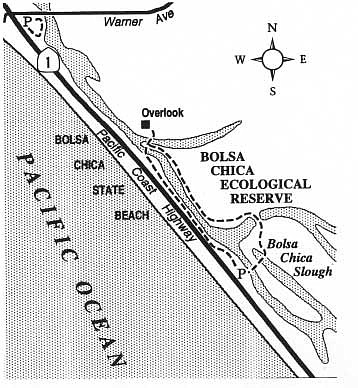 Facebook
Facebook
 X
X
 Instagram
Instagram
 TikTok
TikTok
 Youtube
Youtube
Long ago, extensive saltwater and freshwater marshes lined Orange County's coast between Seal Beach and Newport Beach. The sandy beaches along that coast remain, but most of the wetlands succumbed to the 20th-century tide of housing, industry, and oil exploration. Bolsa Chica Ecological Reserve, 530 acres of partially restored wetlands managed by the California Department of Fish and Game, escaped that fate, but not completely. Don't let the noisy coast highway and creaking oil rocker pumps in the reserve put you off; opportunities for bird watching are excellent. Remember to bring along binoculars, a spotting scope, a camera -- or all of the above.
You can get access to the reserve by way of a 1.5-mile-long public hiking path that starts at a small parking lot opposite the main entrance to Bolsa Chica State Beach. This is on the Pacific Coast Highway 1.5 miles south of Warner Avenue, or 2.5 miles north of Golden West Street.
From the parking lot, a long wooden bridge leads over some shallow stretches of tidewater invaded by typical saltwater marsh plants: cordgrass, alkali heath, sea lavender, and pickleweed. Interpretive panels tell of two endangered species of birds that frequent this area: the least tern, which nests on two small, sandy islands nearby; and the Belding's savannah sparrow, a bird that can drink seawater, processing it with hyperefficient kidneys.
On the far side of the bridge a path goes left atop a levee, eventually encircling a segment of the slough. On the surface and the shoreline you may spot gulls, terns, egrets, cormorants, pelicans, stilts, plovers, avocets, grebes, marsh hawks, herons, and kites. The number and diversity of birds vary with the season.
At the west end of the path, you swing around a tidegate admitting saltwater to the marsh from Anaheim Bay to the north. From this juncture you can walk up to a scenic viewpoint on the lip of a nearby mesa-like terrace. Gabrieleño Indians contemplated a far different scene here prior to about 200 years ago: they beheld a broad, shallow bay extending well inland, rimmed by salt- and freshwater marshes as far as the eye could see.


Long ago, extensive saltwater and freshwater marshes lined Orange County's coast between Seal Beach and Newport Beach. The sandy beaches along that coast remain, but most of the wetlands succumbed to the 20th-century tide of housing, industry, and oil exploration. Bolsa Chica Ecological Reserve, 530 acres of partially restored wetlands managed by the California Department of Fish and Game, escaped that fate, but not completely. Don't let the noisy coast highway and creaking oil rocker pumps in the reserve put you off; opportunities for bird watching are excellent. Remember to bring along binoculars, a spotting scope, a camera -- or all of the above.
You can get access to the reserve by way of a 1.5-mile-long public hiking path that starts at a small parking lot opposite the main entrance to Bolsa Chica State Beach. This is on the Pacific Coast Highway 1.5 miles south of Warner Avenue, or 2.5 miles north of Golden West Street.
From the parking lot, a long wooden bridge leads over some shallow stretches of tidewater invaded by typical saltwater marsh plants: cordgrass, alkali heath, sea lavender, and pickleweed. Interpretive panels tell of two endangered species of birds that frequent this area: the least tern, which nests on two small, sandy islands nearby; and the Belding's savannah sparrow, a bird that can drink seawater, processing it with hyperefficient kidneys.
On the far side of the bridge a path goes left atop a levee, eventually encircling a segment of the slough. On the surface and the shoreline you may spot gulls, terns, egrets, cormorants, pelicans, stilts, plovers, avocets, grebes, marsh hawks, herons, and kites. The number and diversity of birds vary with the season.
At the west end of the path, you swing around a tidegate admitting saltwater to the marsh from Anaheim Bay to the north. From this juncture you can walk up to a scenic viewpoint on the lip of a nearby mesa-like terrace. Gabrieleño Indians contemplated a far different scene here prior to about 200 years ago: they beheld a broad, shallow bay extending well inland, rimmed by salt- and freshwater marshes as far as the eye could see.
